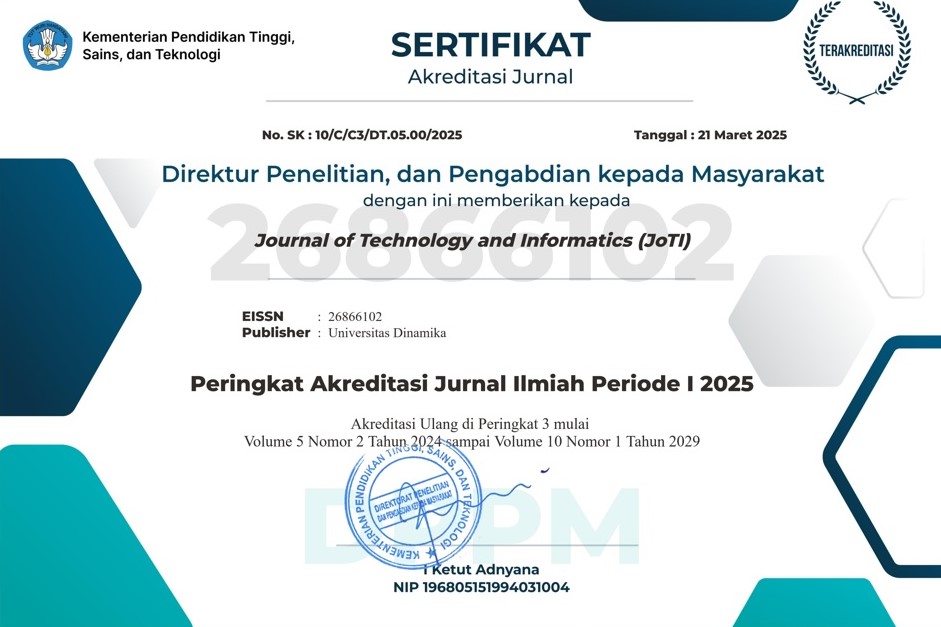Sentiment Perspective of Government's Free Nutritious Meal Policy on Social Media X using Indo-BERT and Bi-LTSM
DOI:
https://doi.org/10.37802/joti.v7i2.1065Keywords:
Sentiment, Algorithm, Indo-BERT, Bi-LSTM, Free Nutritious Meal PolicyAbstract
This research has the potential to make an important contribution to the development of computationally-based sentiment analysis, especially in the context of government policies regarding the Free Meal Program that will be implemented throughout Indonesia. This research was conducted using Indo-BERT and Bi-LSTM algorithms. These approaches were used to categorize emotions into three groups: neutral, negative, and positive. Data is obtained from posts on social media X, then after processing the data, it will be applied to both algorithms, namely Indo-BERT and Bi-LSTM. The research findings show that the model's performance in determining the public sentiment of government policies. Validation and valuation were conducted using the f1 score, recall, and precision metrics. The evaluation findings show that the Indo-BERT algorithm is better than the Bi-LSTM algorithm with an accuracy value of 80% for Indo-BERT and 78% for the accuracy value of the Bi-LSTM algorithm, and the Indo-BERT accuracy value is included in the good classification accuracy value. The sentiment analysis results are also represented by word clouds for each positive, negative and neutral class, providing an intuitive picture of the words frequently used in public discourse on free nutritious meals.
Downloads
References
Eko, “149 Juta Anak di Dunia Alami Stunting Sebanyak 6,3 Juta di Indonesia, Wapres Minta Keluarga Prioritaskan Kebutuhan Gizi,” PAUDPEDIA, 2023. [Online]. Available: https://paudpedia.kemdikbud.go.id/berita/149-juta-anak-di-dunia-alami-stunting-sebanyak-63-juta-di-indonesia-wapres-minta-keluarga-prioritaskan-kebutuhan-gizi?do=MTY2NC01YjRhOGZkNA==&ix=MTEtYmJkNjQ3YzA=. [Accessed: 20-Feb-2024].
R. V. Kübler, A. Colicev, and K. H. Pauwels, “Social Media’s Impact on the Consumer Mindset: When to Use Which Sentiment Extraction Tool?,” J. Interact. Mark., vol. 50, pp. 136–155, 2020.
S. Vashishtha and S. Susan, “Inferring Sentiments from Supervised Classification of Text and Speech cues using Fuzzy Rules,” Procedia Comput. Sci., vol. 167, no. 2019, pp. 1370–1379, 2020.
A. J. N. Kisma, P. Arsi, and P. Subarkah, “Sentiment Analysis Regarding Candidate Presidential 2024 Using Support Vector Machine Backpropagation Based,” JTAM (Jurnal Teor. dan Apl. Mat., vol. 8, no. 1, p. 96, 2024.
H. Al-Omari, M. A. Abdullah, and S. Shaikh, “EmoDet2: Emotion Detection in English Textual Dialogue using BERT and BiLSTM Models,” 2020 11th Int. Conf. Inf. Commun. Syst. ICICS 2020, pp. 226–232, 2020.
P. Subarkah, P. W. Rahayu, I. Darmayanti, and R. Riyanto, “Sentiment Analysis on Reviews of Women’S Tops on Shopee Marketplace Using Naive Bayes Algorithm,” JITK (Jurnal Ilmu Pengetah. dan Teknol. Komputer), vol. 9, no. 1, pp. 126–133, 2023.
Y. Wang, J. Guo, C. Yuan, and B. Li, “Sentiment Analysis of Twitter Data,” Appl. Sci., vol. 12, no. 22, pp. 1–14, 2022.
M. K. Insan, U. Hayati, and O. Nurdiawan, “Analisis Sentimen Aplikasi Brimo Pada Ulasan Pengguna Di Google Play menggunakan Algoritma Naive Bayes,” J. Mhs. Tek. Inform., vol. 7, no. 1, pp. 478–483, 2023.
M. R. F. Kamarula and N. Rochmawati, “Perbandingan CNN dan Bi-LSTM pada Analisis Sentimen dan Emosi Masyarakat Indonesia Di Media Sosial Twitter Selama Pandemik Covid-19 yang Menggunakan Metode Word2vec,” J. Informatics Comput. Sci., vol. 04, pp. 219–228, 2022.
P. Subarkah, H. A. A. Rozaq, P. Arsi, S. A. Sholikhatin, R. Riyanto, and H. Marcos, “Implementation of Text Mining to Detect Emotions of Fuel Price Increase Using BERT-LSTM Method,” Gazi Univ. J. Sci., vol. 37, no. 4, pp. 1707–1716, 2024.
G. Boateng and T. Kowatsch, “Speech emotion recognition among elderly individuals using multimodal fusion and transfer learning,” ICMI 2020 Companion - Companion Publ. 2020 Int. Conf. Multimodal Interact., pp. 12–16, 2020.
H. Jayadianti, W. Kaswidjanti, A. T. Utomo, S. Saifullah, F. A. Dwiyanto, and R. Drezewski, “Sentiment analysis of Indonesian reviews using fine-tuning IndoBERT and R-CNN,” Ilk. J. Ilm., vol. 14, no. 3, pp. 348–354, 2022.
M. Lestandy and Abdurrahim, “Exploring the Impact of Word Embedding Dimensions on Depression Data Classification Using BiLSTM Model,” Procedia Comput. Sci., vol. 227, pp. 298–306, 2023.
Z. Purwanti and Sugiyono, “Pemodelan Text Mining untuk Analisis Sentimen Terhadap Program Makan Siang Gratis di Media Sosial X Menggunakan Algoritma Support Vector Machine ( SVM ),” vol. 5, no. 3, pp. 3065–3079, 2024.
W. Anggriyani and M. Fakhriza, “Analisis Sentimen Program Makan Gratis Pada Media Sosial X Menggunakan Metode NLP,” vol. 5, no. 4, pp. 1033–1042, 2024.
Y. Z. Vebrian, T. Informatika, and U. N. Waluyo, “A Sentiment Analysis Of Free Meal Plans On Social Media Using Naïve Bayes Algorithms,” vol. 10, no. 1, 2025.
R. K. Jalli, L. Priyadarshini, P. K. Dash, and R. Bisoi, “Identification of multiple power quality disturbances in hybrid microgrid using deep stacked auto-encoder based bi-directional LSTM classifier,” e-Prime - Adv. Electr. Eng. Electron. Energy, vol. 11, no. May 2024, p. 100919, 2025.
Y. Li, “Research on the Construction and Optimization of Physical Education Teaching Analysis Platform Based on Bi-LSTM Model,” Syst. Soft Comput., p. 200265, 2025.
U. B. Mahadevaswamy and P. Swathi, “Sentiment Analysis using Bidirectional LSTM Network,” Procedia Comput. Sci., vol. 218, pp. 45–56, 2022.
Sugiarti, P. Arsi, P. Subarkah, D. I. S. Saputra, and V. Jay, “Sentiment analysis of Indonesian government policy in the era of social commerce : public perception and reaction,” vol. 8, no. 2, pp. 236–246, 2024.
W. Zhang, L. Li, Y. Zhu, P. Yu, and J. Wen, “CNN-LSTM neural network model for fine-grained negative emotion computing in emergencies,” Alexandria Eng. J., vol. 61, no. 9, pp. 6755–6767, 2022.
E. Kına and R. Özdağ, “Deep Learning vs. Machine Learning in Sentiment Classification: A Comparative Analysis of Mobile Game Tweets from the X Platform,” Erzincan Üniversitesi Fen Bilim. Enstitüsü Derg., vol. 18, no. 2, pp. 639–658, 2025.
Downloads
Issue
Section
License
Copyright (c) 2025 Journal of Technology and Informatics (JoTI)

This work is licensed under a Creative Commons Attribution-ShareAlike 4.0 International License.


















